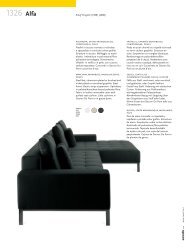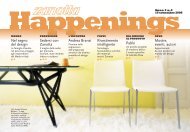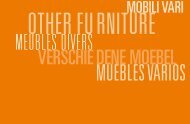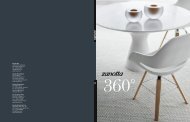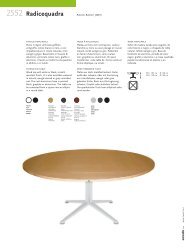Happenings - Zanotta SpA
Happenings - Zanotta SpA
Happenings - Zanotta SpA
You also want an ePaper? Increase the reach of your titles
YUMPU automatically turns print PDFs into web optimized ePapers that Google loves.
FOCUS<br />
Lighting in a solid state will be the<br />
next “disruptive technology”.<br />
New alchemists for new lighting.<br />
<strong>Happenings</strong><br />
no.3/06 p.9<br />
New LED Technology: a challenge!<br />
In 1992 the Japanese Shuji Nakamura perfected the<br />
industrial production process of a minute<br />
electronic component (with just a few millimetres’<br />
surface) that issued weak blue light rays. It was the<br />
work of ten years, which cost three million dollars. Thus<br />
began, in a remote Japanese region famous for its spas<br />
and start up companies of solid state electronics, a<br />
production technology for light that was recently<br />
classified by the US Department for Development as<br />
“disruptive technology”, a devastating technology that<br />
will alter a sector of human activities at the very root. Few<br />
recall how things were before the advent of “containers”<br />
in the crucial transport sector. Something similar will<br />
occur in lighting too. Technologies for the creation of<br />
light in the solid state will provide the post-modern<br />
domestic and urban scene with light - even infrared light -<br />
with negligible dissipation of energy and heat and<br />
remarkable resistance to shock, vibrations, wear and tear.<br />
These “bulbs”, which function at a low voltage - often<br />
below 24 volts - could radically redefine the electrical<br />
safety of homes. The risk of electrocution caused by the<br />
use of alternate 220V current would also be less.<br />
LIGHT LIKE GOLD<br />
The L.E.D. - acronym for Light-Emitting Diode - is a<br />
“diode that issues light”. If ancient alchemists sought the<br />
way to knowledge amidst metals and if they anxiously<br />
sought the way to transmute a humble metal into a more<br />
noble one (gold seemed the best choice to many),<br />
modern technologists have found present day gold once<br />
again amidst metal: light, the real wealth of our age and<br />
the real essence of modernity. Today the value of a little<br />
block - just a few cubic centimetres large - of purified<br />
silica makes hundreds of chests full of gold coins grow<br />
pale. Produced in establishments based on “clean<br />
rooms”, environments in which air is constantly purified,<br />
LEDs are produced by processing small silica bars that<br />
have been treated in various manners. The result is a<br />
minute device made by combining a precious metal and<br />
a “non metal”. Controllable light radiation issues from<br />
their link up region when a weak current flows through it.<br />
THE CHANGES INSIDE<br />
There are two immediate consequences for both project<br />
planners and designers: extreme flexibility and<br />
manoeuvrability, a wide selection of shapes and control<br />
of both the flow and the colour of light. The firm instead<br />
enjoys significant energy saving and greater safety<br />
features. The advantages of LED-based lighting for living<br />
and public environments in the first instance number<br />
miniaturised light sources (clearly visible, they challenge<br />
projects and product designers) and the subsequent<br />
choice of multiple lighting for spectacular effects;<br />
secondly they involve long duration, reliability, saturated<br />
colour and the option to play with dynamic chromatisms.<br />
Combined with easy to programme control circuits,<br />
which are less bulky than a remote control, LEDs open<br />
the doors to new opportunities both for designers and<br />
buyers: the option of changing a light source’s quality,<br />
intensity and colour at a later date. Written with the<br />
collaboration of Flavio Vida.<br />
The new bulb leds by Philips match the various lamp types.




